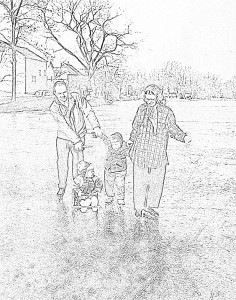New Year’s Resolution: Make 2012 Your Year for Breakthrough English
(Wiktionary) break•through /ˈbreɪkθruː/: Characterized by major progress or overcoming some obstacle
Would you like to improve your English? Would you like 2012 to be a “breakthrough year” for you with English? Perhaps you’ve been trying to learn English for several years, and you feel like you’re not making the progress you had hoped.
Be encouraged – you can make 2012 your year for Breakthrough English! Follow these five simple tips, and make them a habit:
• Study English Every Day
• Read English Every Day
• Listen to English Every Day
• Practice English Every Day
• Learn New Vocabulary Every Day
Study English Every Day
The first tip for Breakthrough English is to study English every day. This is a key step. The human brain is structured to learn by repetition. This means the more often you study, the better you will learn the material. Because of this, you will actually learn English better if you study every day for 15 minutes (as an example) than if you study once a week for 1 hour and 45 minutes (15 minutes a day for 7 days).
So, find time to study English every day. It can be 10 minutes, 15 minutes, 20 minutes, or whatever fits your schedule. Commit to that daily study, and watch your English improve!
Read English Every Day
Here is the second tip for Breakthrough English: in addition to studying English every day, it is a good idea to read English every day. Even if you study grammar and do exercises every day, you still need to read English daily. “Authentic” materials – books, magazines, newspapers, and so on – are best, since they use words and phrases that are common with native English speakers.
It is easy to find reading material that matches your English level. Even easy books like children’s books or comic books have something for intermediate or advanced ESL students as well as beginners. Obviously, the simple vocabulary and short sentences of children’s books make them suitable for beginners. At the same time, children’s books often contain various phrases and cultural ideas that make them a worthwhile reading challenge for upper-level ESL students.
By reading English every day, you will develop an “ear” for English. You will begin to notice when an English word or phrase “sounds right” because it’s being used correctly. You will also begin to notice when something “sounds strange” (for example, sounds like “Japlish” or “Konglish”) because of a wrong preposition or other incorrect vocabulary. So, the more you read, the more natural or native-like your own English will become.
Daily reading of authentic materials is a powerful method to help your English get better and better. Commit to daily reading, and watch your English improve!
Listen to English Every Day
The third tip for Breakthrough English is the “flip side” of reading English every day: listening to English every day. You can get the same vocabulary benefits as in reading, plus you can hear the pronunciation of the words.
Many ESL students don’t listen to as much English as they should. Why? Because they are frustrated from listening to a level that is too challenging for them. You want to listen to material where you understand about 75% of what is said.
Listen, listen, and listen again. Don’t be afraid to keep on listening until you are comfortable with all (95% +) of the material. Remember, our brains are structured to learn by repetition – take advantage of it! Load up your mp3 player with English, and listen to it at every opportunity – when you exercise, when you ride the subway or walk to work, when you cook or do housework, and so on.
What kinds of materials are good to listen to? It doesn’t matter – podcasts, news reports, audio books are all good. Pick something that is interesting to you. If you like it, you will want to listen to it again and again, and the repetition will help you.
But try to listen to “normal English” programs rather than “special English.” Why? Because people don’t speak English like the “special English” programs.
Many ESL students who listen only to “special English” type materials think that they are well-prepared for listening to English. Unfortunately, they are often quite shocked to find out that they understand very little (maybe only 25%) when they try to listen to native English speakers.
You can avoid this by listening to normal English every day and absorbing it into your brain. Your brain will accept the sounds and speech patterns of native English speakers as a standard or model for your own English. This will help your pronunciation tremendously, and you will be better understood by others when you speak English.
Daily listening is another effective tool to help you get better in English. Commit to daily listening, and watch your English improve!
Practice English Every Day
The fourth tip for Breakthrough English is to practice English every day. There are two ways that you can practice English daily: speaking, and writing.
It is easiest to practice speaking every day if you can find a language partner of some sort. Can you find an English speaker who is willing to have a conversation with you on a regular basis? You don’t have to talk to the same person every day – you can have a different person for each day of the week. Live internet chat (like Skype, for example) makes it easier than ever to find people to talk to from around the world.
If you can’t find someone to talk to on a regular basis, there are still other ways to get some daily speaking practice in English. Is there some place where you can find English tourists? Do you meet English speakers in your work sometimes? Most English speakers would be happy to spend at least a few minutes talking with ESL students, so don’t be afraid to give it a try. Just ask them politely: “Excuse me, I am trying to learn English. Would you mind talking with me for a few minutes?” Even if they say no, you still get some practice in by asking the question!
If you absolutely can’t find anyone to talk to in English, you can always talk to a pet, a baby or young child, or even to yourself. At first it may seem strange, but you will get used to it. Don’t be afraid of feeling foolish – it is natural to talk to yourself like that. Children do it all the time. It helps them learn their native language, and it will help you learn English.
The important thing is that you will become more comfortable in expressing yourself in English. The more you practice speaking, the easier it will become. As you get better, you will find that you don’t have to think so much to speak English. Eventually, you won’t have to translate all the time before you say something in English. Your English will sound more natural, and you will be more and more fluent.
The other way to practice English daily is by writing. Find a pen pal (or several!) that you can write to. Keep a journal, and write down your thoughts or experiences every day. Again, the important thing is to get used to expressing yourself in English. The nice thing about writing is that you have time to think about what you want to say, and how to say it. You also have time to look up words before you use them. You usually don’t have that opportunity when practicing speaking!
Daily practice is another essential method of getting better in English. Commit to daily practice – speaking and / or writing – and watch your English improve!
Learn New Vocabulary Every Day
Our final tip for Breakthrough English is this: learn some new vocabulary every day. It doesn’t matter how many vocabulary words or phrases you learn, but pick a number you know you can commit to learning every day – 5 new words or phrases a day, 10 new words or phrases a day, whatever is comfortable for you. But definitely make it a daily habit to expand your English vocabulary.
Learning new vocabulary is crucial for improving your English. Without enough vocabulary, it will be difficult for you to express yourself in English. The more vocabulary words or phrases you know, the easier it will be for you to say what you are thinking. Learning more vocabulary will also make it easier for you to understand what you read or hear when you are studying and practicing English.
What kinds of words or phrases should you learn? After learning basic vocabulary, pick words or phrases that are useful or interesting for you. This will make it easier for you to learn and to remember the new words or phrases. Use your new words or phrases, too, for repetition – this will also make them easier to remember.
Try to find examples of your new words or phrases being used in sentences. Pay attention to how they are used. They will seem more “real” to you that way than words or phrases that come from a list somewhere. Listen for your new words or phrases in English listening materials. Very often you will notice new words or phrases because you are now aware of them. Learn from others, so you can pick up correct pronunciation and usage from the start.
Daily learning of new vocabulary is another powerful tool to help you get better in English. Commit to daily learning new vocabulary, and watch your English improve!
Key: Every Day
Notice that each of these five tips involves the words “every day.” This is an important point. Consistency – doing something with English every day – is the key.
There is an old riddle in English:
Question: How do you eat an elephant?
Answer: One bite at a time!
Many times we look at a project or goal, and we think it is too difficult for us because it seems too big for us. We look at the elephant, and we get discouraged because we know the whole elephant will not fit in our mouth. But if we break up that elephant into bite-sized pieces – if we take things one step at a time, take things day by day – we find that we can achieve our goal or finish our project.
It is the same with learning English. Improving in English seems like a big project. But if you take one step at a time, day by day, you will find that you will achieve your goal of improving your English. Commit to these five tips, and you will make 2012 your year for Breakthrough English!
Do you like this article? Do you have any questions? Contact us for more suggestions and information!




